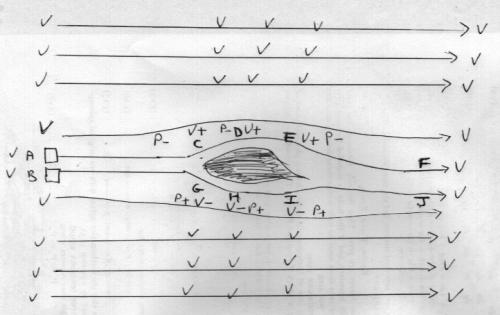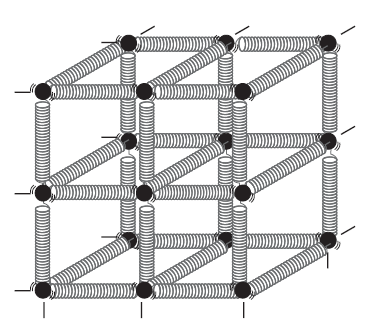-
Posts
18270 -
Joined
-
Last visited
-
Days Won
104
Content Type
Profiles
Forums
Events
Everything posted by studiot
-
J.C.MacSwell, You seem to know a thing or two about fluids so I don't want to try to "teach my grandfather to suck eggs". The analysis of fluid action can be approached from at least two viewpoints. The Eulerian approach of following a parcel of fluid and calculating its path (position), change of shape, orientation and other properties. The control volume approach of fixing a specific volume in space so that it does not vary in shape or position and calculating the flows of energy, momentum and mass across its boundaries. The point I have been trying to make is how to select the most appropriate for the issue at hand and in particular that these two approaches should not be mixed, as Zet is trying to do. The examples in post83 are best handled by the control volume approach. The entire L shaped duct is made into the control volume. Attempting to use this control volume approach to the open air flow will fail because the volume must extend to infinity, meaning that the energy supply is infinite so the prime statement/assumption 'energy is conserved' is violated.
-
Here is one bold example from a 21 page poster. You need a bit more information than on this one page (this could be insets and headings) The basic idea is Ask a (broad) question and provide a (broad) answer. And invite closer inspection of the paper for more detail. Here is another one from my themes list.
-
With respect I see nothing steady about the flow in the post83 example, which I have offered to discuss.
-
By poster do you mean a printed presentation on a board? This is very common in medical circles, I have done a few for others. You need to think how many pages and how large? At what height will the board be sited? Viewers will not look at anything below chin level so put the most important point at the top. Choose a theme. Useful examples are Onwards and upward Step by Step The bear went over the mountain to see what lay beyond A jigsaw puzzle Idea balloons Balancing. Yes you are right, tell a story. But use the theme to break it into logical sections and show the development. I will try to look out some examples.
-
OK so you mean pathlines, which are a function of time. Streamlines are at one particular instant in time.
-
Sorry, your terminology is imprecise. Are you referring to streamlines, pathlines or what? Can you post a link or better a picture.? Incidentally, Bernoulli is blown wide open of you allow stream lines to divide, or join, since one way of stating the theorem is The total energy is constant along a streamline. So if two join the total energy becomes indeterminate. and then it becomes impossible to solve for dynamic and static pressures, velocities etc. If you like I will show how Bernoulli and streamlines should be applied to the example in post 83
-
The first part is correct, there is no lift without circulation, but I'm not convinced about the second part. There are a lot of possible combinations of compressible/incompressible and viscid / inviscid flows, as well as laminar / turbulent. I'm not sure what you mean by 'they' meet at a stagnation point, streamlines cannot intersect and end at a surface.
-
The impeller / propeller bit is easy, I'm sure you can improvise. Driving it for 24 hours or so, have you considered compressed air as a power source? The air could drive a fan that drove the impeller in the water. SJ's comments are one way. The actual fan need not have any physical connection to the impeller. That is how my central heating pump works. There is an electrically driven impeller in one chamber that is spearated from the impeller in the water chamber by a membrane. Both impellers are magnetic. A shaft passing through your cap via a sealing gland could also be spun by an air impeller, driving a water impeller in your sample tube. Yo need to dismantle some old central heating pumps.
-
Sounds interesting, but I'm not exactly clear what you want to do. Perhaps if you explained what you want to do in (slightly) more detail?
-

Deep learning weight adjustment clarity sought
studiot replied to PerceptualRobots's topic in Mathematics
I know nothing about the underlying subject matter of neural networks, deep or otherwise. But the equation you refer to looks like a standard finite element iteration/discretisation from t to (t+1) where delta is the shift function and t is the iteration counter in some numerical approximation of the underlying mathematical equation. Since steepest descent methods are discussed, I would hazard a guess that this is due to linearization of an underlying nonlinear controlling mathematical equation. This is a common numerical approach in such cases. -
Two numbers, arc. That is all that is that is needed to answer Billiard's question in post#378 fully and completely. Billiards asked you to identify the location of compression on your graph and you have yet to do this some 10 posts later, despite a great deal of typing. Since your graph has scaled axes two numbers will suffice. We cannot discuss the reasons until we understand what you are claiming is (or was) in compression so all the other typing was an unfortunate waste of effort.
-
You are correct to note that all are vectors and that the odd one out is to do with change of direction, not magnitude. A,C, D & E are all vectors in the same plane as the circle, and their directions do indeed change as the child runs round the circle. However B, the angular velocity is at right angles to the plane of the circle, poking out from the cente of the circle in right handed screw fashion. This makes it (the only one) constant in both magnitude and direction. This concept is important in Chemistry for magnetic and dipole moments. Draw a diagram if you need to convince yourself.
-
Larry, this is not an angle of attack question. You can have any angle you like and any shape you like. This is to try to get folks to think about the fluid as well as the obstruction. Note, I have not said there are no pressure changes. We can measure pressure changes so the logic presented must be flawed.
-
Blind misapplication of Bernoulli can lead you wildly astray. Here are some more conundrums to ponder. With reference to the diagram. An airflow is proceeding from left to right with steady velocity V and pressure P until it encounters an obstacle. Consider two parcels of air at A and B with such velocity V and pressure P. The 'Bernoulli Explanation' is supposed to run as follows: Parcel A passes over the top of the obstruction, gaining velocity over the stream velocity, Which I have shown as V+ at C, D, and E then finally returning to match the stream at F at velocity V. As a result it is claimed that Bernoulli's theorem says the static pressure must fall below stream pressure at C, D, and E (shown as P-) returning to p at F. In mirror fashion parcel B passes under the obstruction and looses velocity, denoted V- but gains pressure at G, H and I (denoted P+) , returning to V and P at J. So the pressure difference exerts a net upward force on the obstruction, causing it to rise and extract energy from the stream. Question 1) If parcels A and B between them loose some energy to the obstruction, where does the energy come from to rejoin the stream at stream pressure and velocity? Question 2) When parcel A has velocity V+ and pressure P-, then its pressure is less than the pressure of the air immediately above it in the undisturbed stream. So why does it not rise. Question3) Similarly when parcel B has velocity V- and pressure P+ its pressure is greater than the air immediately below it so why does it not fall?
-
Hello Essay, The problem is that I have never been comfortable with the following statements A simple treatment of energy regards objects as "point particles", and it is the view taken by Zet. This view has a special definition in Physics such that it regards all the mass of a body as being concentrated at a single point. Whilst this view can suffice in the case of the mechanics of simple solid objects is is entirely inadequate fot fluid bodies as a whole. In particular the mass of a fluid body cannot be considered as a point particle, but is distributed throught the entire body. Solid objects can possess mechanical energy in four forms Kinetic Energy, Rotational Energy, Field Energy (eg gravitational), Internal Energy The children with their hoops are demonstrating rotational energy. When they are bowling these along that brings in kinetic energy. If they are bowling them uphill they are adding gravitational field energy Here is the repository for the fourth type internal energy. The springs can twist and flap, extend and contract. All of which changes the internal energy whilst the object can be regarded as the same entity. Internal energy is so much more important for fluids. So when considering energy balances all four forms need to be considered. Often we need only consider two for solid objects, but we always need to consider at least three for fluids. I said before that Bernoulli represents an energy accounting for a fluid and as such you have four terms in the full expression. If we limit discussion to an irrotational fluid for the moment the four terms have particular names in physics The kinetic energy is called the kinetic head or kinetic pressure The internal energy is called the static head or static pressure The field energy is called the gravitational head and is the gravitational potential energy per unit volume. Now I explained, back in posts# 93, 98 & 100, that Zet has not provided enough information to distribute energy added to or taken from the fluid between these three, using Bernoulli. A possible key missing variable is the volumetric flowrate. I have tried to keep this discussion nonmathematical as requested. A final point the static pressure in a fluid should not be confused with the stagnation pressure. The stagnation pressure is the pressure of the fluid if it is brough to rest so all the kinetic energy is turned into internal energy, or if you like the static pressure when the velocity is zero.
-
The advertisers have got hold of the phrase blue graphite so googling this is unproductive. There are competing purification technologies, which can be found by googling graphite purification.
-
First let me congratulate you on thinking about the question and finding the easy way, Exactly as I suggested It is usually convenient to take moments about one of the forces so you do not have to include that force in the calculation. They do not normally teach this, so once again well done +1 As to what went wrong with the beam balance method: After correcting my arithmetic error (0.024 kg per centimetre should have been 0.0024), you made one of your own. Moments are force x distance and you forgot to multiply by the distance. Compare my lines 4 and 6 with yours. A flag should have been that I said a quadratic in d and you did not get one It is good to spot short cuts, but you should become comfortable with my method for two reasons Firstly because it is the general method, you will not always be able to take moments about an end. Secondly because the problem is very similar to the workings of a Chemist's analytical beam balance. The additional 2.6 kg weight is like the rider (although rather larger than most riders it is similar to riders used in medical and vetinary practice). So I have reproduced the solution in some detail, correctly arriving at 95 cm. Some points to note are that the value you use for g does not matter. g cancels throught the equation. This is important since it shows that the Chemist's beam balance is independent of g and does not need to be corrected for it. Secondly the equation looks fearsome at first, but have faith. College questions are designed to work out with easy numbers. The quadratic terms cancel, reducing the equation to a simple one. And the akward fractions, decimals and large numbers fall out to any easy non calculator solution. This is also a good point to demonstrate how to pick up exam marks. The key equation is line 8, as set out it shows you understand force x distance and balancing clockwise and anticlockwise moments. You would get 3/4 marks out of say 5 available for this line. There would probably ony be 1 more mark for the rest of the arithmetic down to line 15.
-
Looking more closely at Zet's words I find he has included the weight of the airfoil in the pale typeface so apologies for missing this. However these words are at variance with his diagrams since Zet does not include the weight or any fixing force in his diagrams so they are all flawed force balances.
-
How much else have you made up? Do you mean to say that you have invoked Bernoulli's theorem, but you don't know what static pressure is? Codswallop. Weightless objects only exist in fantasy.
-

Hi im new here, looking for more info on Geocentrism.
studiot replied to Scotty99's topic in Speculations
There's no such thing as bad publicity. And look how many fell for it. How many times has sundiculuos name now been listed on this respected Science website ? It must have risen in the search engines and webratings. Geocentricity is a model. And a very useful model at that. Used by more people the world over than any other, at all times in history, including now. The sun rises in the East and sets in the West. The First Point of Aeries transits at 0350.257893 hours and so on. But we all use models we know are incorrect, usually for the same reason. They make the calculation of something we want to know easier and close enough. Take virtual work. We all know it is a fantasy, but a very useful fantasy in simplifying some calculations. It is just a shame when someone starts to believe that his model is 'reality' and becomes obsessed with the idea, perhaps even to the extent of fiddling results to 'prove it'. Of course they are inevitably found out in the end. The list of such scandals is at least as long as the list of those 'were right but not listened to' Go well -

Mathematics - the language of a deterministic Universe?
studiot replied to quanta'namo nay!'s topic in Mathematics
So to recap I offered you Heisenberg's Uncertainty principle which is not deterministic in our physical world and you have not replied. I offered you Bessel's equation, which has no solution in our mathematical world, although we can get very good approximations. I also mentioned other areas. The humble arch, one of the simplest structural forms that has been much used for thousands of years has no known mechanical solution, although again we have approximations. The loads on a bridge are not deterministic. So if I asked you to design an arch bridge deterministically, what what load would you specify and how would you analyse it to get 'determine' an answer? If you were an electrical engineer the actual load on a cable is not predictable, you would use 'the diversity theorem' when designing wiring for say a kitchen installation. If you are going to claim that every real outcome in this universe can in theory be predicted with 100% accuracy by some mathematical equation you must be prepared to offer an equation for any that ask. -

Hi im new here, looking for more info on Geocentrism.
studiot replied to Scotty99's topic in Speculations
A good up-to-date read for the semi technical is A Perfect Theory P G Ferreira This has much interesting historical and background material as well as a developmental approcah to modern Astrophysics -
Rasen, you managed to solve the chemistry and maths questions you posted with a little help and can obviously cope with science. However it is clear from your questions that you have missed some physics so try this explanation. I asked what was the definition of the centre of gravity (for your purposes it is also the centre of mass if you prefer to call it that). Since you did not answer The centre of gravity (mass) is the point through or at which all the weight (mass) of a body can be considered to act. So that is the exact centre of a rectangular bock such as the one in my Fig1. I have drawn an arrow to show the weight (W) acting vertically downwards through this point. Now any force has a moment about any point not on its line of action. So I have shown that W has a moment about the corner (A) of the block and also about some point B outside the block. You should understand that you can take a moment about any point you like. Obviously some points are more convenient than others and the trick (experience) is choosing the best point. Ok so if we imagine a light frame of negligable mass, shown dashed in Fig2, that just fits out blocks, and slide a block of weight W into one end as shown. This arrangement is not in balance but don't worry we will build up to that. The frame is mounted on a fulcrum at the centre so our standard block exerts a moment of WL1 about the fulcrum. If we now slide the block along the frame as in Fig3 the moment changes to WL2. In fact the moment varies as we slide the block along the frame, but we are still not in balance. If we now add a second matching block to the frame but on the other side of the fulcrum we can achieve balance if the distances from the fulcrum are equal. That is balance requires a mass on each side of the fulcrum. These masses generate opposing moments that balance each other out. So how is all that related to our solid metre ruler? Well if we now fill up the frame with blocks we will again achieve balance, since the fulcrum is at the middle point. In just the same way we can balance our ruler on a fulcrum placed at its middle point. So another way to look at this is to say that we can consider the ruler made up of an assemblage of blocks. I have done just this in Fig5. The left hand side is made up of three equal blocks. The right hand side is made up of a single continuous block, like the ruler. And these two sides balance! So that shows how two of the three forces are generated. From the left hand side and right hand side of the ruler look at my first diagram in post#4 The third force is of course the additional weight that is placed on the end of the ruler. I have not done so but it is an interesting exercise to prove in my Fig5 that the anticlockwise moments do indeed equal the clockwise ones. To do this work out the distances in terms of L3. You should do this to convince yourself that you can divide up a continuous block into pieces in this way or assemble the contributions from individual pieces to one whole. You will meet this technique again and again in more advanced work.
-

Hi im new here, looking for more info on Geocentrism.
studiot replied to Scotty99's topic in Speculations
If you google " a wacky theory" or "a wacky theory that fits my prejudices" you get plenty of nonsense. or you could just listen to ajb instead and get the facts.








